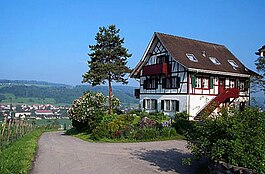Oberembrach
| Oberembrach | ||
|---|---|---|
 |
||
|
||
| Coordinates: 47°29.262′N 8°37.107′E / 47.487700°N 8.618450°ECoordinates: 47°29.262′N 8°37.107′E / 47.487700°N 8.618450°E | ||
| Country | Switzerland | |
| Canton | Zurich | |
| District | Bülach | |
| Area | ||
| • Total | 10.25 km2 (3.96 sq mi) | |
| Elevation | 459 m (1,506 ft) | |
| Population (Dec 2015) | ||
| • Total | 1,066 | |
| • Density | 100/km2 (270/sq mi) | |
| Postal code | 8425 | |
| SFOS number | 0065 | |
| Surrounded by | Brütten, Embrach, Kloten, Lufingen, Nürensdorf, Pfungen, Winterthur | |
| Twin towns | Trhova Kamenice (Czech Republic) | |
| Website |
www SFSO statistics |
|
Oberembrach is a municipality in the district of Bülach in the canton of Zürich in Switzerland.
Oberembrach is first mentioned in 1274 as Obern-Emmerach. However, the village was not an independent municipality until 1809. Before that date it was part of the municipality of Embrach.
Oberembrach has an area of 10.2 km2 (3.9 sq mi). Of this area, 58.3% is used for agricultural purposes, while 34.1% is forested. Of the rest of the land, 7.3% is settled (buildings or roads) and the remainder (0.2%) is non-productive (rivers, glaciers or mountains).
The municipality is located in the upper Wildbachtal. It includes the Haufendorf (an irregular, unplanned and quite closely packed village, built around a central square) of Oberembrach. In addition to the village, it includes the hamlets of Hausen, Madlikon, Mühlberg, Ober-, Untermettmenstetten, Ober-, Unterwagenburg, Rotenfluh, Sonnenbühl, Stigen and Stürzikon. In 1871 the hamlets of Augwil and Vordermarchlen were removed from Oberrembrach and transferred to Lufingen. In 1927 the hamlets of Eigental, Hinter- and Vorderbänikon were transferred to Kloten.
Oberembrach has a population (as of 31 December 2015) of 1,066. As of 2007[update], 6.8% of the population was made up of foreign nationals. Over the last 10 years the population has decreased at a rate of -0.9%. Most of the population (as of 2000[update]) speaks German (95.1%), with French being second most common ( 1.0%) and Portuguese being third ( 0.8%).
In the 2007 election the most popular party was the SVP which received 51.7% of the vote. The next three most popular parties were the FDP (10.6%), the SPS (9.1%) and the CSP (9%).
...
Wikipedia



